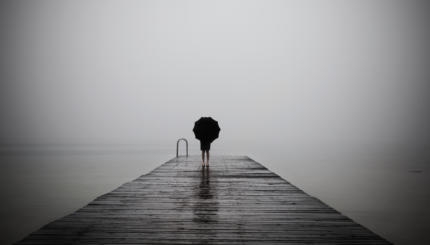Excerpted with permission from Saying Kaddish: How to Comfort the Dying, Bury the Dead, & Mourn as a Jew (Schocken Books).
[Filling the grave] is the most striking part of a Jewish funeral, surely the most painful, and perhaps ultimately the most healing.
Depending on the local custom, while the coffin is lowered into the earth, or just prior to filling the grave, the rabbi or cantor recites:
Al mekomo yavo veshalom (for a man)
With your help, My Jewish Learning can provide endless opportunities for learning, connection and discovery.
Al mekomah tavo veshalom (for a woman)
May _______ go to his/her place in peace.
The rabbi then hands one of the principal mourners a trowel or simply gestures for him or her to pick up the shovel placed beside or in a pile of newly dug earth. Children, parents, siblings, and spouse come forward, taking turns dropping a little of the soil onto the coffin.
According to one custom, mourners use the back of the shovel at first, to demonstrate reluctance. In some communities, each mourner replaces the shovel back in the earth rather than hand it from one person to the next–a practice probably born of the idea that death is somehow contagious. However, others find it comforting to give the spade to the next person, acknowledging the shared nature of the task.
After the immediate family has symbolically buried their loved one, others come forward to take a turn with the shovel….
Alternatives
Although many liberal Jews follow this tradition, some find it too painful. Sometimes mourners request that the coffin be delivered to the cemetery and placed into the grave before they arrive at the cemetery. Some families are uncomfortable with throwing dirt onto the coffin, especially when children are among the principle mourners, and drop flowers onto the coffin instead of earth.
Most rabbis gently try to dissuade mourners from leaving before the coffin is lowered, for both religious and psychological reasons. The idea of leaving the mitzvahof burial entirely in the hands of paid strangers deprives the family of its last act of kevod ha-met, respect for the dead. Even more important, helping to fill the grave means you have left nothing undone. The echo of earth falling on the wooden coffin is the terrible and haunting sound of finality. After you have emptied a shovel onto a loved one’s casket, there is no denying death–which makes it possible for healing to begin.
Sign up for a Journey Through Grief & Mourning: Whether you have lost a loved one recently or just want to learn the basics of Jewish mourning rituals, this 8-part email series will guide you through everything you need to know and help you feel supported and comforted at a difficult time.
Looking for a way to say Mourner’s Kaddish in a minyan? My Jewish Learning’s daily online minyan gives mourners and others an opportunity to say Kaddish in community and learn from leading rabbis.


